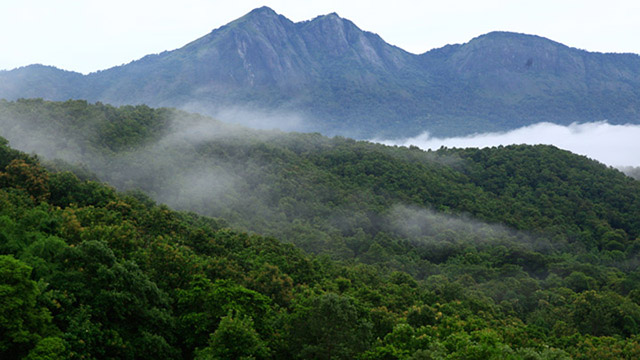Silent Valley National Park: A Sanctuary of Tranquility in the Western Ghats

Shrouded in the mystical embrace of the Nilgiri Hills in Kerala, India, lies Silent Valley National Park – a pristine jewel untouched by the clamor of civilization. This verdant sanctuary, established in 1984, is a testament to the delicate balance between human progress and environmental preservation. Encompassing a core area of 89.52 square kilometers, fringed by a buffer zone of 148 square kilometers, Silent Valley is a triumph of a decades-long conservation movement that saved this irreplaceable ecosystem from destruction.
The name “Silent Valley” is not merely a moniker; it aptly captures the park’s essence. Unlike the cacophony of cicadas that usually characterizes rainforests, Silent Valley offers a sense of profound peace. The gentle murmur of streams, the rustle of leaves in the breeze, and the occasional call of a bird create a symphony of tranquility that washes over visitors, a stark contrast to the frenetic pace of modern life.
This tranquility is a testament to the park’s status as one of the last remaining tracts of pristine tropical evergreen forest in the entire Western Ghats. The dense canopy formed by towering trees creates a cathedral-like atmosphere, with shafts of sunlight filtering through the emerald foliage and illuminating the lush undergrowth. The air itself is thick with the intoxicating aroma of ancient trees and damp earth, an olfactory signature that defines Silent Valley.
But Silent Valley’s magic lies not just in its serene atmosphere but also in its unparalleled biodiversity. The park is a haven for a staggering variety of flora and fauna, many of them endemic to the Western Ghats. Over 1,200 species of flowering plants, including the endangered medicinal herb Agastyachetta, carpet the forest floor. Giant ferns unfurl their prehistoric fronds, while towering trees like the majestic Muthanga (Terminalia crenulata) pierce the sky. This botanical tapestry provides a vital habitat for a menagerie of creatures.
Silent Valley is a flagship reserve for the lion-tailed macaque, an endangered primate with a distinctive golden mane framing its black face. These playful and intelligent creatures swing through the canopy with acrobatic grace, their presence a constant reminder of the park’s ecological significance. The dense undergrowth teems with other mammals, including the elusive Malabar civet cat, the shy Indian pangolin, and the nocturnal flying squirrel. The park is also home to a diverse array of reptiles and amphibians, including the endemic pit viper Hypnale longicaudata and the brightly colored Malabar gliding frog.
The avian symphony of Silent Valley is as breathtaking as its flora and fauna. Over 200 species of birds call this park home, their vibrant plumage adding a splash of color to the verdant canvas. The mournful wail of the Malabar laughingthrush echoes through the trees, while the iridescent blue of the kingfisher flashes past, a fleeting glimpse of beauty. Birds of prey like the crested serpent eagle and the grey-headed fish eagle soar overhead, their keen eyes scanning the forest for prey.
Beyond its rich biodiversity, Silent Valley holds immense historical and cultural significance. Archaeological evidence suggests that indigenous communities have inhabited the fringes of the park for millennia, living in harmony with the forest. Their traditional knowledge and practices hold valuable lessons for sustainable living in a fragile ecosystem.
However, Silent Valley’s journey to protected status was not without its challenges. In the 1970s, plans for a hydroelectric project threatened to submerge a significant portion of the park under a reservoir. A fierce environmental movement, spearheaded by passionate individuals and organizations like the Save Silent Valley Committee, rose in opposition. This grassroots movement, one of the most significant environmental protests in India’s history, ultimately led to the park’s designation as a protected area, ensuring its survival for generations to come.
Today, Silent Valley National Park stands as a beacon of hope, a testament to the power of collective action in protecting our natural heritage. However, the challenges of conservation are ongoing. Threats like invasive species, habitat fragmentation, and climate change necessitate constant vigilance and innovative solutions.
A visit to Silent Valley National Park is not just a vacation; it’s a pilgrimage to a sanctuary of serenity. Trekking through the verdant expanse, one is humbled by the towering trees and the symphony of life. The park offers limited eco-tourism opportunities, allowing visitors to experience its magic responsibly. Guided nature walks provide an opportunity to learn about the park’s unique ecosystem, while birdwatching expeditions allow visitors to witness the avian spectacle firsthand.
Silent Valley National Park is a legacy to be cherished, a reminder of our responsibility to protect the natural world. As we step out of its verdant embrace, we carry within us a renewed sense of peace and a commitment to ensuring that the tranquility of Silent Valley continues to echo through the ages.




